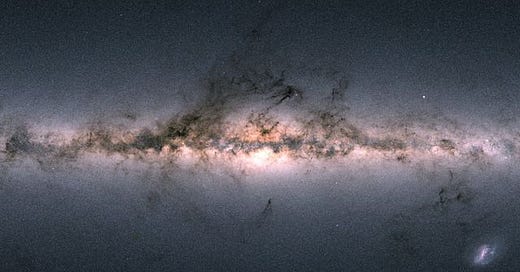Our galaxy would be almost as old as the universe!
13 billion years, or 800 million years after the Big Bang. This would be the age of certain regions of the Milky Way, according to a study published in the journal Nature. A result that extends its birth by 2 billion years and would lead to rewrite the history of our galaxy.
Milky Way
Map of the Milky Way made with the latest catalog from the European Gaia satellite
ASTRONOMY. Our galaxy, the Milky Way, which hosts some 200 billion stars and measures more than 100,000 light-years in diameter, could be getting quite old. According to work published in the journal Nature, some regions would have begun to form 13 billion years ago, that is to say 800 million years only after the Big Bang ... and 2 billion years more than what astronomers imagined until now! The study is signed by Maosheng Xiang and Hans-Walter Rix, two scientists from the Max-Planck Institute for Astronomy in Heidelberg, Germany.
Anatomie de la Voie lactée ( illustration by ESA )
Hydrogen atoms no longer fuse
The duo of researchers has reconstructed the history of the Milky Way by determining the age of 250,000 stars that serve as tracers of sorts. They belong to the "sub-giant" family and correspond to a particular stage in the life of stars when hydrogen atoms no longer fuse in their core. The production of energy then moves to a layer surrounding the nucleus causing a swelling of the star. This evolutionary stage, which precedes the transformation into a "red giant", is relatively brief: it lasts "only" a few million years, which allows us to date the age of these stars with precision.
Information on the luminosity and chemical composition of stars
It is still necessary to be able to characterize them, to identify them as such. To do this, the German scientists have relied on two types of data: those of the EDR3 catalog, delivered in 2020 by the European Gaia satellite, and those of the LAMOST (Large Sky Area Multi-Object Fibre Spectroscopic Telescope) located in eastern China. While the former have provided information on the luminosity of stars, the latter have given researchers information on their chemical composition, including their "metallicity" (the fraction of their mass that is not composed of hydrogen or helium).
A 6000 light-year high disk
By combining these data and relying on complex computer simulations, the age of these 250 000 stars could be determined with an unprecedented level of accuracy. The analyses indicate that most of the stars in our galaxy were formed in two distinct phases. The first phase began 13 billion years ago in a region of the Milky Way called the "thick disk", 6000 light years high. It includes the central bulge and the "thin disk", so called because it is three times thinner. This one is however more extended. It also contains the arms of the galaxy as well as the majority of the stars of the whitish band visible to the naked eye in the night sky.
The thick disk of our galaxy is almost three times as high
Collision between two galaxies
The second phase would have been initiated two billion years later, when a dwarf galaxy called Gaia-Enceladus collided and merged with our young galaxy. The thick disk would then have filled with a large number of stars. And the thin disk would itself have emerged only 5 to 6 billion years later following a new wave of star formation of which the Sun was part. These discoveries "revolutionize our vision of when and how our galaxy formed," says Maosheng Xiang in a statement from the European Space Agency. A confirmation and more details could be brought very soon by the James-Webb space telescope, which will be operational in June and will study the first galaxies such as the Milky Way, but also by the next catalog of Gaia expected also in June 2022.






